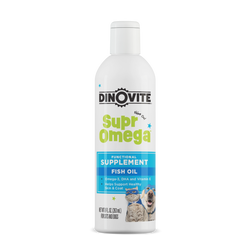9 Signs Your Dog Could Have Allergies

9 Signs Your Dog Could Have Allergies
Dogs can develop allergies just like humans, and these allergies can significantly affect their comfort and quality of life. Whether it’s dog seasonal allergies, food allergies, or dog environmental allergies, identifying the signs early can help you manage your dog’s symptoms and improve their well-being.
Here are nine common signs of allergies in dogs to help you spot potential problems:
Allergies in Dogs: Symptoms
- Itchy Skin. One of the most obvious signs of allergies in dogs is persistent itching. Dogs may scratch, lick, or chew their skin, paws, or ears excessively. This is often seen with dog environmental allergies caused by allergens like pollen, dust, or mold.
- Skin Irritation. Redness, rashes, or hives are common in dogs with allergies. Inflamed skin, hot spots, or sores may also develop from excessive scratching or licking. Seasonal and food allergies can both cause visible skin issues.
- Ear Infections. Allergic reactions can make dogs prone to ear infections, which present as itchy, inflamed ears, frequent head shaking, or a foul odor. This is especially common in dogs with floppy ears, as allergens can accumulate in the ear canal.
- Watery Eyes. Red, watery, or irritated eyes can be a sign of dog seasonal allergies, especially during spring and fall when pollen counts are higher.
- Sneezing and Runny Nose. Dogs, like humans, can sneeze and have a runny nose when exposed to allergens. This symptom is common with dog environmental allergies and may occur more frequently outdoors.
- Stomach Upset. Food allergies in dogs can result in digestive problems such as vomiting, diarrhea, gas, or bloating. If your dog frequently experiences these symptoms, their diet could be the culprit.
- Lethargy. Allergies can leave your dog feeling sluggish or less active than usual. Discomfort from itching, ear infections, or other symptoms can drain their energy.
- Changes in Skin and Coat. Allergies can affect your dog’s coat and skin condition, leading to hair loss, dry or flaky skin, and a dull coat. This is especially true for dogs with dog seasonal allergies or food sensitivities.
- Excessive Paw Licking. Dogs with allergies often chew or lick their paws excessively. This behavior can cause redness, irritation, and even infections if left unaddressed.
If you notice these symptoms, consult your veterinarian for a proper diagnosis. A vet can help identify the cause of your dog’s allergies and recommend a treatment plan that may include dietary changes, medications, or allergen avoidance strategies.
At What Age Do Most Dogs Develop Allergies?
Dogs can develop allergies at any age, but most begin to show signs between 6 months and 3 years of age. This is when their immune systems are fully developed, and they’re more likely to react to allergens in their environment or diet.
Some breeds are predisposed to developing allergies, including Retrievers, Bulldogs, Terriers, and German Shepherds. However, any dog can develop allergies, so monitoring for signs is essential regardless of breed or age.
How to Figure Out What Your Dog Is Allergic To
Always consult a vet before taking any course of action. Determining what’s causing your dog’s allergies can feel like solving a puzzle, but there are steps you can take:
- Observe Symptoms. Note when and where symptoms occur. For example: Is your dog scratching more after being outside? This could indicate dog environmental allergies like pollen or grass. Do symptoms worsen after meals? Food allergies may be to blame.
- Conduct an Elimination Diet. If you suspect a food allergy, work with your veterinarian to introduce a limited-ingredient or hypoallergenic diet. Gradually reintroduce ingredients to identify the trigger.
- Allergy Testing. Veterinarians can perform blood or skin tests to identify specific allergens, such as dust mites, molds, or certain foods. These tests can help pinpoint triggers and guide treatment.
What Time of Year Do Dogs Get Allergies?
Dog seasonal allergies are most common in the spring and fall when environmental allergens like pollen, grass, or weeds are at their peak. Here’s a breakdown of when allergens are most prevalent:
- Spring (March-May): Tree pollen is the primary culprit.
- Summer (June-August): Grass pollen becomes more prominent.
- Fall (September-November): Weeds like ragweed release pollen, causing allergic reactions.
If your dog’s symptoms follow a seasonal pattern, they may have dog seasonal allergies. Keep an eye on symptoms like sneezing, watery eyes, and itching during these times of the year.
What Can I Feed My Dog to Reduce Shedding and Allergies?
While allergies often require a multi-faceted approach, nutrition plays a significant role in managing symptoms. Feeding your dog a diet rich in these nutrients can help:
- Omega-3 Fatty Acids. Found in fish oil, these reduce inflammation, support skin health, and improve coat condition. Omega-3s can help minimize itchy skin and excessive shedding caused by allergies.
- Limited-Ingredient Diets. Dogs with food allergies may benefit from diets with fewer ingredients or hypoallergenic proteins (e.g., salmon or duck). These diets help eliminate potential allergens while providing balanced nutrition.
- Antioxidants. Antioxidants like vitamin E and zinc can support your dog’s immune system and reduce allergy-related symptoms.
Always consult your veterinarian before making significant dietary changes to ensure your dog’s nutritional needs are met.
%20(2).png)
Managing Dog Allergies: Tips and Tricks
If your dog suffers from allergies, these steps can help alleviate symptoms:
- Minimize Exposure to Allergens. For dog environmental allergies: Wipe your dog’s paws and coat after walks to remove pollen and dust. Vacuum and clean your home frequently to reduce indoor allergens like dust mites.
- Use Allergy-Friendly Grooming Products. Bathe your dog with hypoallergenic shampoos to soothe itchy skin and wash away allergens. Regular grooming can also help reduce shedding and skin irritation.
- Provide a Balanced Diet. Include omega-3 fatty acids, antioxidants, and high-quality proteins to support healthy skin and reduce allergy symptoms.
- Consult Your Vet. For severe allergies, your vet may recommend medications such as antihistamines, steroids, or allergy shots. These treatments can provide relief while you work on managing triggers.
Conclusion
Allergies in dogs can be frustrating, but understanding the signs and causes is the first step toward relief. Whether your dog is dealing with dog seasonal allergies, food sensitivities, or environmental triggers, proactive care can help manage their symptoms and improve their quality of life.
From observing symptoms to providing the right diet and seeking veterinary care, there are plenty of ways to support your pup through allergy season. Remember, your veterinarian is your best resource for diagnosing and treating your dog’s allergies.
*All information on this website is for educational purposes only and is not intended to replace the expert advice of a veterinarian or veterinary practitioner.
Related Products

